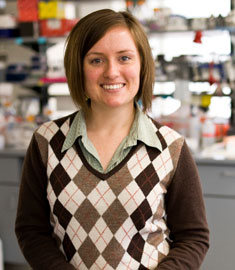Tracking the Bugs
Cummings School Ph.D. graduate identifies pathway for common parasite transmission
By Catherine O’Neill Grace

Research by Siobhan Mor has found that people can contract cryptosporidiosis by inhaling the tiny parasite. Photo: Alonso Nichols
A group of hospitalized children in Africa has given public health researchers new clues about the transmission of a microscopic parasite that can kill people with weakened immune systems.
Cryptosporidium, a gastrointestinal bug that is found around the globe, can make just about anyone sick, even healthy adults. The infection—called cryptosporidiosis—is usually transmitted when people drink water contaminated by the feces of infected humans or livestock. The disease causes acute diarrhea, abdominal pain, vomiting and fever.
Now some pathogenic detective work by Siobhan Mor, V09, the second student to complete a Ph.D. at the Cummings School of Veterinary Medicine, has uncovered a new portal for infection: the parasite can be inhaled.
“Crypto” is a worldwide public health issue, according to the Centers for Disease Control and Prevention, which reports that some 300,000 cases are diagnosed annually in the United States—an estimate that may be artificially low since testing for crypto is rarely done. The illness is widespread among undernourished children and vulnerable populations in Africa, including people with HIV/AIDS.
Mor traveled to Kampala, Uganda, to study patterns of cryptosporidiosis transmission in children who were hospitalized for severe diarrhea. She particularly wanted to find out how the children got cryptosporidium in their lungs.
It had been thought that the parasite only invaded the lungs of people with HIV/AIDS whose immune systems are compromised. However, “we have shown that the respiratory tract is commonly involved in infection in HIV-negative children, and that is a breakthrough,” says Mor, noting that her findings suggest that people may actually breathe in the pathogen.
Mor hastens to add that her conclusion, as well as previous research in Uganda, is based on studying the disease in densely populated urban areas. She would like to replicate these studies in rural Uganda to determine if the findings also apply in more sparsely populated regions. “We need to get out into the provinces,” she says, acknowledging that the lack of infrastructure in rural Africa poses challenges for this kind of public health research.
Earlier this year, Mor successfully defended her doctoral dissertation, “Epidemiology of Cryptosporidiosis and Related Infections in Sensitive Populations.” She joins Zenda Berrada, V08, in a very exclusive club—the only Ph.D. graduates of the Cummings School.
Mor grew up in Australia and received her veterinary training at the University of Sydney. She started out thinking she would practice equine medicine. But that changed when she arrived at the Cummings School and began doing cryptosporidium research with Saul Tzipori, professor of microbiology and infectious diseases and the Agnes Varis University Chair in Science and Society. Led by Tzipori, infectious disease researchers at the veterinary school have been studying cryptosporidium for many years.
“My experience studying crypto taught me that a vet degree is much more than a vet degree,” says Mor. “I became fascinated with how our work can serve public health, not just veterinary health. I needed to go to vet school to understand that it was public health I wanted to do.”
She’ll be able to pursue that passion in her new job: she has been appointed a research assistant professor in the department of public health and family medicine at Tufts University School of Medicine.
This story first appeared in the Spring 2009 Tufts Veterinary Medicine magazine.
Catherine O’Neill Grace can be reached at catherine.grace@tufts.edu.

